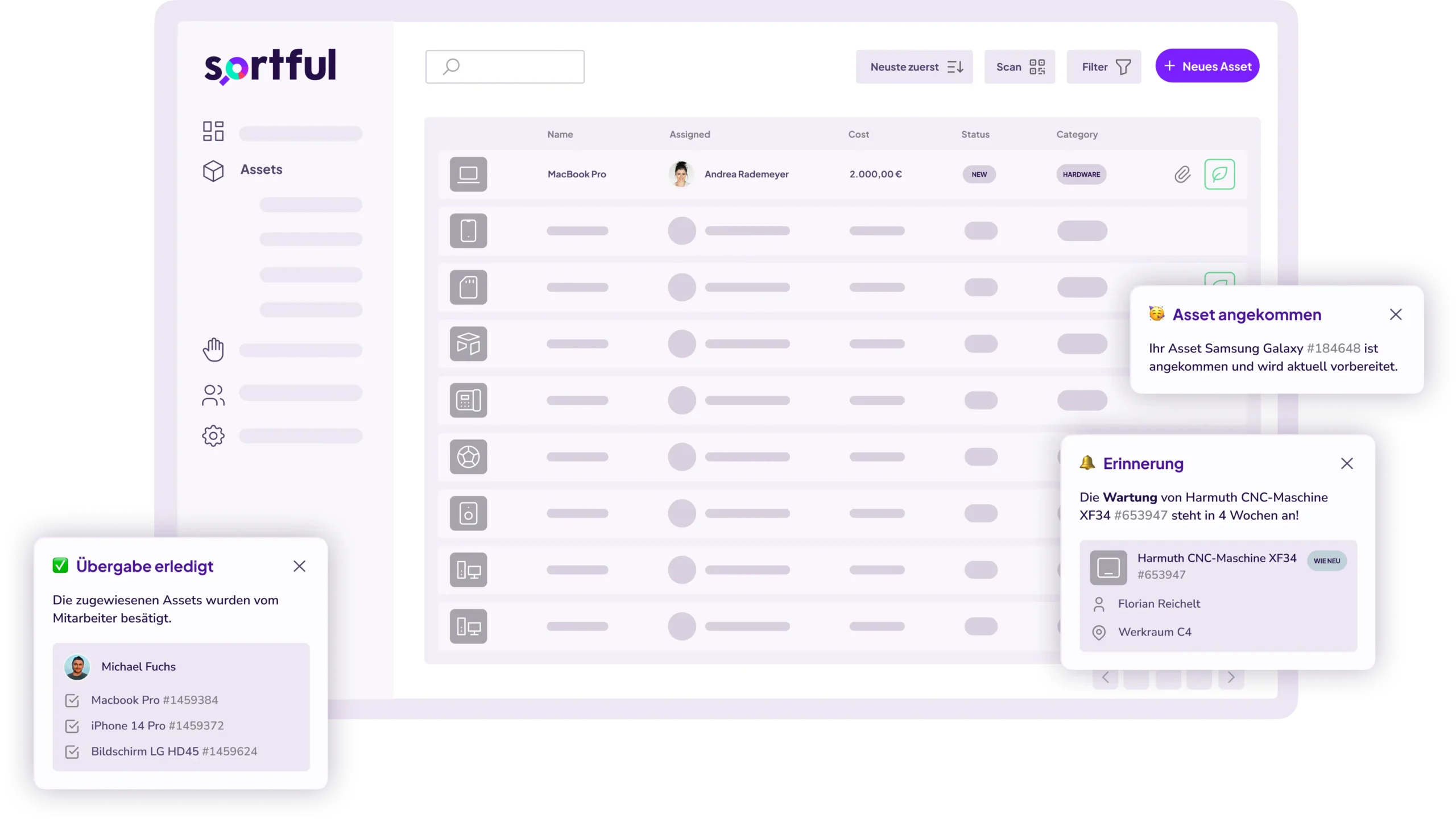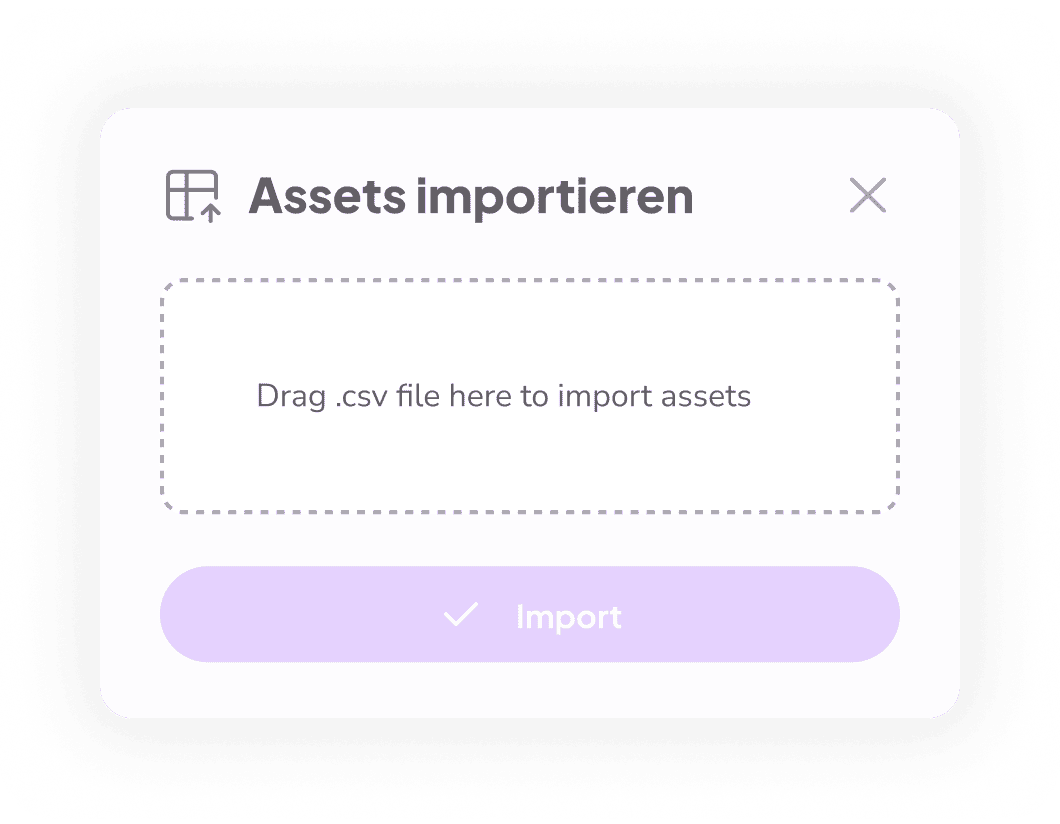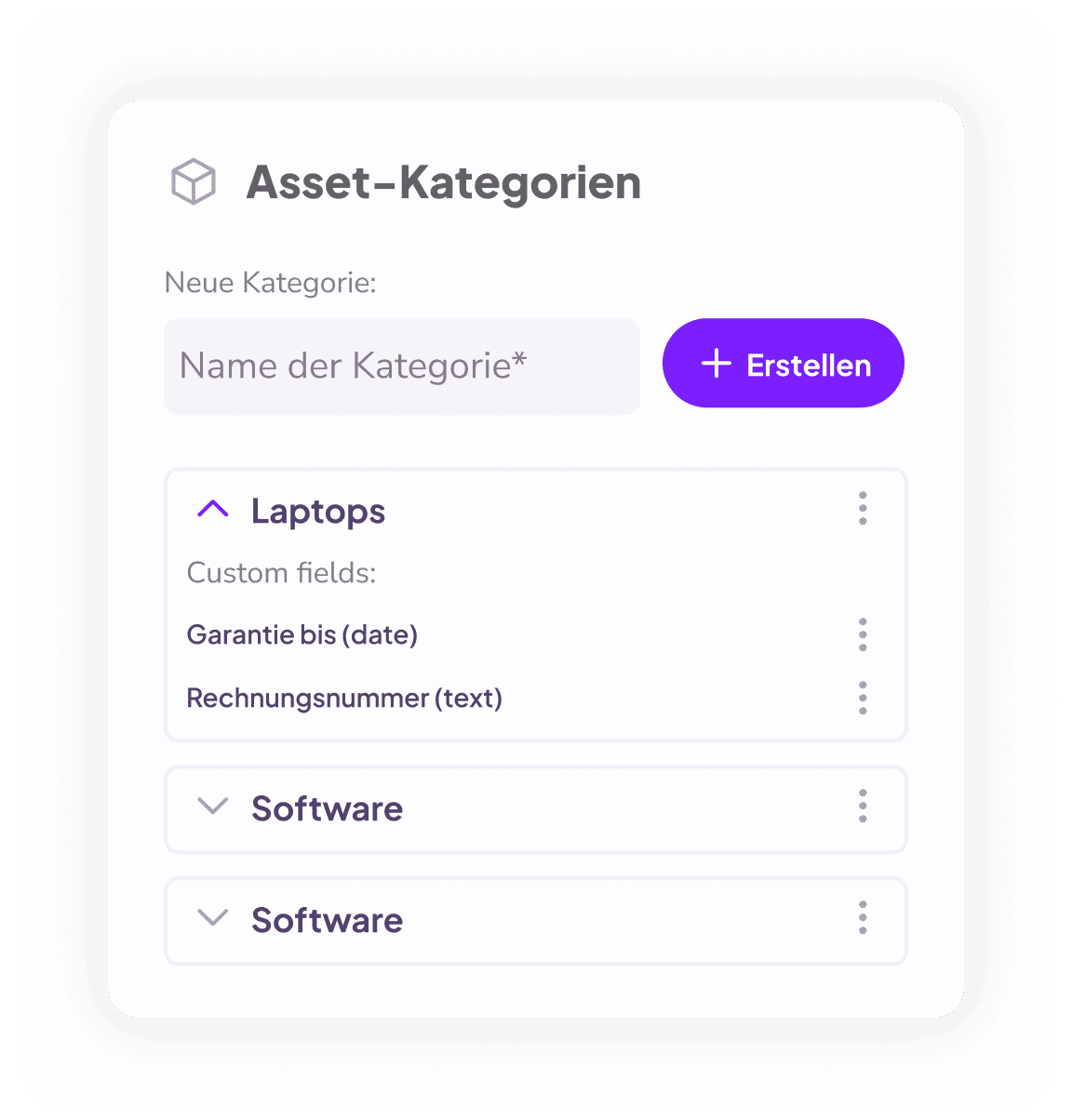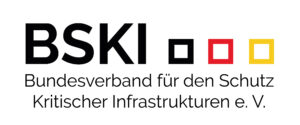Inventarisierung. Einfach.
Mit der sortful Inventarisierungssoftware managen und organisieren Sie
Ihr Inventar von jedem Ort zu jeder Zeit. Es ist super easy, kostensparend und nachhaltig.

Genutzt von



Kosten sparen durch smarte Inventarisierung
Smarte Inventarisierungssoftware für die Verwaltung Ihrer Geräte, Maschinen, IT-Hardware, Büroinventar und anderer Vermögenswerte spart Kosten. Berechnen Sie jetzt mit dem Kalkulator, wie viel Sie pro Jahr sparen können. Und erhalten Sie Tipps, wie Sie ihre Nachhaltigkeitsbilanz durch den Verkauf von alten und nicht mehr benötigten Assets optimieren können.
Inventarverwaltung made easy
Neues Tool bedeutet Projektierung, Schulungen und umfangreiche Dokumentationen wälzen? Nope. Sortful ist intuitiv nutzbar ohne lange Einarbeitungszeit oder aufwändige Trainings – ob für IT-Administratoren, Office Manager oder HR professionals – Sortful ermöglicht einen schnellen und unkomplizierten Einstieg in die Inventarverwaltung. Eine kurze onboarding-session und los geht’s! Sie haben bereits eine statische Asset-Liste? Dann können Sie diese ganz einfach importieren.


Komplett angepasst auf Ihr Unternehmen
Sie definieren Ihr Inventar, Sortful steuert den Inventarisierungsworkflow.
Egal um was es geht – IT Hardware, smartphones, Geräte, Maschinen, Lizenzen oder Lager- und Verbrauchsmaterialien – mit Sortful bilden Sie die Struktur Ihres Inventars und Ihrer Organisation passgenau ab. Und mit nur wenigen Klicks definieren Sie Ihre eigenen Felder, die für Sie wichtig sind,


Umfassendes Asset-Tracking
Mit Sortful wissen Sie immer, welcher Person welches Inventar zugewiesen ist und an welchem Standort es sich befindet. Via QR-Code-Scanner haben Sie über Ihr Smartphone sofort Einblick in alle relevanten Daten eines Assets. Übergaben werden digital bestätigt und protokolliert. Sortful informiert Sie automatisch, wenn Garantien oder Leasingverträge auslaufen, bei anstehenden Wartungen oder wenn wichtige Assets bald nicht mehr vorrätig sind. Mit unserer Depot-Funktion sehen Sie auf einen Blick, welche Assets aktuell verfügbar sind und vermeiden dadurch Überbestellungen.
Mit Sortful sparen Sie Kosten, Ihre Organsation wird effizienter, Sie agieren nachhaltig und sicher in der Cloud
Für Unternehmen ist eine funktionierende Inventarisierung von
Mitarbeitergeräten (Notebooks, Handy, etc.), IT-Hardware und anderen
Unternehmensassets essentiell. Scheitern diese
Prozesse, entstehen Mehrkosten, Störungen im operativen Ablauf und eine
schlechte Experience für MitarbeiterInnen.
Kosteneinsparung
Unternehmen, die ein IT-basiertes Tool zur Inventarisierung einführen, können ihre Assetkosten um 30% im ersten Jahr und um 5-10% in den Folgejahren reduzieren. Die größten Einsparungen gibt es im Einkauf, in der Entsorgung und Operations.
Nachhaltigkeit durch Refurbishing
Inventarisieren Sie nachhaltig durch Refurbishing und Reselling mit unserer Software. Mit nur wenigen Klicks können Sie den Refurbish-Prozess für alte oder ungenutzte Geräte und Maschinen starten. Unsere Partner erstellen Ihnen einen Kostenvoranschlag und kümmert sich um alles weitere (formales Angebot, Logistik). Dabei steht Sicherheit an erster Stelle: Revisionssichere Datenlöschung und Datenträgervernichtung werden compliancegerecht und datenschutzkonform durchgeführt und dokumentiert.
Effiziente Organisation
Durch digitale Inventarisierung können Unternehmen sicherstellen, dass notwendige Hardware und Geräte wie Laptops, Handys, Tablets, etc. jederzeit verfügbar sind, um die Produktivität der Mitarbeiter zu erhöhen. Mit einem einfachen Überblick über das vorhandene Inventar können Engpässe schnell erkannt und behoben werden.
Sicher in der Cloud
Dank der Cloud-Technologie von Sortful sparen Sie sich Installations- und Wartungsaufwand. Wir kümmern uns um automatische Updates von Bugfixes und neuen Features. Unsere Hosting-Server stehen in Deutschland und sind durch SSL-Verschlüsselung geschützt. Außerdem beachten wir die Datenschutz-Grundverordnung (DSGVO) und schließen mit Ihnen eine Vereinbarung zur Auftragsverarbeitung ab. Dabei stellen wir Ihnen eine Liste unserer Subauftragnehmer sowie eine Beschreibung der technisch/organisatorischen Maßnahmen zur Verfügung. So können Sie sich auf die sichere Verwaltung Ihres Inventars konzentrieren.
Das sagen Kunden, die bereits mit uns arbeiten

Meiko-Timo von Oesen (Data at Work GmbH)
Der Aufbau der App ist sehr übersichtlich und beinhaltet nur die Funktionen, die wirklich benötigt werden. Keine Vielzahl von Unterpunkten, die kein Anwender je benutzen wird. Somit wird auch nur das bezahlt, was gewünscht & benutzt wird! Der persönliche Kontakt zum Team (und der daraus resultierende Support) ist sehr gut, super schnell und es wird auch auf persönliche Anfragen & Bedürfnisse eingegangen.
Das passende Lizenzmodell für Ihr Unternehmen
Unser Lizenzmodell zeichnet sich durch seine Einfachheit und Transparenz aus, ohne versteckte Kosten. Jeder Plan beinhaltet standardmäßig Onboarding und Support, und nahezu alle Funktionen sind in jedem unserer Pläne verfügbar.
Small
Für kleine Unternehmen & Organisationen
59,00 €
/ Monat
- Verwaltung von bis zu 500 Assets
Grow
Für mittelständische Unternehmen
139,00 €
/ Monat
- Verwaltung von bis zu 2000 Assets
- plus Refurbishing
Professional
Die high end-Lösung für große Unternehmen
499,00 €
/ Monat
- Verwaltung von bis zu 5000 Assets
- plus Anfragenmanagement
Enterprise
Für Konzerne und Großunternehmen
Kundenspezifisch
- Verwaltung von unlimitierter Anzahl an Assets
- plus REST-API
- plus Active Directory Integration
- plus dedizierter Customer Success Manager
Sortful Blog zu Inventarisierung
Aus My SAM wird sortful
Durch clevere Inventarverwaltung Bestellprozesse optimieren
8 Vorteile von Inventarmanagement
Häufig gestellte Fragen
Die Inventarisierung ist ein grundlegender Prozess, der für Unternehmen und Organisationen von entscheidender Bedeutung ist. Es bezieht sich auf die systematische Erfassung, Verwaltung und Nachverfolgung aller Vermögenswerte, die für den reibungslosen Ablauf des Geschäftsbetriebs und die Erreichung der Unternehmensziele von entscheidender Bedeutung sind. Diese Vermögenswerte können eine breite Palette von Gegenständen und Ressourcen umfassen, darunter:
Geräte und Maschinen: Hierzu gehören beispielsweise Computer, Drucker, Mobiltelefone, Produktionsmaschinen, Fahrzeuge und andere technische Geräte, die für den Betrieb des Unternehmens erforderlich sind.
Hardwarekomponenten: Dazu zählen Computerkomponenten wie Prozessoren, Speicher, Festplatten und Netzwerkgeräte, die in IT-Infrastrukturen zum Einsatz kommen.
Softwarelizenzen: Unternehmenssoftware, Betriebssysteme, Anwendungen und Tools erfordern eine lizenzierte Nutzung. Die Inventarisierung umfasst die Aufzeichnung dieser Lizenzen, um eine rechtmäßige und ordnungsgemäße Verwendung sicherzustellen.
Möbel und Einrichtungsgegenstände: Büromöbel, Konferenzraumeinrichtungen und andere Ausstattungsgegenstände werden ebenfalls in die Inventarisierung einbezogen.
Dokumente und Akten: Auch Dokumente, Akten und andere schriftliche Unterlagen können Teil der Inventarisierung sein, insbesondere wenn ihre Verfügbarkeit und Organisation wichtig sind.
Der Inventarisierungsprozess beginnt in der Regel mit einer gründlichen Erfassung aller vorhandenen Vermögenswerte. Dabei werden relevante Informationen wie Seriennummern, Herstellerdaten, Standorte, Anschaffungsdaten und Wartungspläne erfasst. Diese Daten dienen als Grundlage für die effiziente Verwaltung und den reibungslosen Betrieb der Vermögenswerte. Die Verwaltung der Inventardaten umfasst regelmäßige Aktualisierungen, um Änderungen wie Neuanschaffungen, Reparaturen oder Ausmusterungen zu berücksichtigen.
Eine genaue Inventarliste ermöglicht es Unternehmen, den Überblick über ihre Vermögenswerte zu behalten und potenzielle Engpässe oder ineffiziente Ressourcennutzung frühzeitig zu erkennen. Die Nachverfolgung von Vermögenswerten ist ein weiterer wichtiger Aspekt der Inventarisierung. Sie hilft dabei, die Bewegungen von Assets innerhalb des Unternehmens oder zwischen verschiedenen Standorten zu überwachen. Dies ist besonders hilfreich, um Diebstähle, Verluste oder Verwechslungen zu vermeiden und eine genaue Bestandsführung sicherzustellen.
Moderne Inventarisierungssoftware wie Sortful unterstützt Unternehmen bei der effizienten Durchführung dieses Prozesses. Mit automatisierten Funktionen zur Datenerfassung, benutzerfreundlichen Schnittstellen und Integration in bestehende IT-Systeme ermöglicht sie eine optimierte Verwaltung der Vermögenswerte und trägt so dazu bei, den Geschäftsbetrieb zu optimieren und die Kosten zu reduzieren.
1. Transparente Vermögensverwaltung: Eine gründliche Inventarisierung ermöglicht es Unternehmen, alle Vermögenswerte, sei es Hardware, Software, Maschinen oder Mobiliar, in einer zentralen Datenbank zu erfassen. Dies schafft Transparenz über den gesamten Bestand und erleichtert die Identifizierung und Lokalisierung der Assets.
2. Kostenkontrolle: Die Erfassung und Verwaltung der Vermögenswerte ermöglicht es Unternehmen, ihre Kosten im Blick zu behalten. Durch das rechtzeitige Erkennen ungenutzter oder ineffizient genutzter Assets können unnötige Ausgaben vermieden werden. Unternehmen können besser planen, welche Ressourcen benötigt werden und welche nicht, was zu einer effizienteren Budgetierung führt.
3. Optimierung von Wartungszyklen: Eine genaue Inventarisierung erleichtert die Planung von Wartungs- und Reparaturarbeiten für Geräte und Maschinen. Regelmäßige Wartung kann dazu beitragen, teure Ausfälle zu verhindern und die Lebensdauer der Assets zu verlängern. Dadurch werden langfristig Instandhaltungskosten reduziert.
4. Ressourcennutzung optimieren: Die effiziente Inventarisierung ermöglicht Unternehmen, die Nutzung ihrer Vermögenswerte zu optimieren. Durch das gezielte Zuweisen von Geräten und Ressourcen an bestimmte Mitarbeiter oder Abteilungen können Engpässe vermieden und die Produktivität gesteigert werden.
5. Compliance und rechtliche Sicherheit: Die genaue Erfassung von Assets, insbesondere bei Softwarelizenzen, gewährleistet die Einhaltung von Lizenzbedingungen und gesetzlichen Vorschriften. Unternehmen können sicherstellen, dass sie über die erforderlichen Lizenzen verfügen und somit rechtlichen Problemen vorbeugen.
6. Risikomanagement: Eine umfassende Inventarisierung unterstützt Unternehmen dabei, Risiken zu minimieren. Dazu gehört beispielsweise die Identifizierung von veralteten oder nicht mehr unterstützten Geräten und Software, die Sicherheitslücken aufweisen könnten. Durch die frühzeitige Erkennung solcher Risiken können Unternehmen proaktiv Maßnahmen ergreifen, um ihre IT-Infrastruktur zu schützen.
7. Nachhaltigkeit und Umweltschutz: Die Inventarisierung spielt auch eine Rolle im Bereich der Nachhaltigkeit. Indem Unternehmen den Lebenszyklus ihrer Vermögenswerte verfolgen und optimieren, können sie den Verbrauch von Ressourcen reduzieren und ihren ökologischen Fußabdruck verringern. Dies schafft eine umweltbewusste Unternehmenskultur und spricht zunehmend umweltbewusste Kunden und Partner an. Insgesamt fördert eine effiziente Inventarisierung eine professionelle Unternehmensführung und ermöglicht es, die vorhandenen Ressourcen optimal zu nutzen. Moderne Inventarisierungssoftware wie My SAM vereinfacht diesen Prozess und unterstützt Unternehmen dabei, ihre Vermögenswerte gezielt zu verwalten, Kosten zu senken und ihre Geschäftsprozesse effektiv zu gestalten.
1. Ungenaue Datenerfassung: Eine der häufigsten Herausforderungen besteht darin, genaue und zuverlässige Daten über die Vermögenswerte zu erfassen. Manuelle Dateneingaben sind anfällig für Fehler, und in großen Unternehmen kann es schwierig sein, den Überblick über alle Assets zu behalten. Ungenaue Daten können zu Inkonsistenzen in der Inventarliste führen und die Entscheidungsfindung beeinträchtigen.
2. Veraltete Bestandslisten: Unternehmen, die noch auf veralteten Methoden wie Excel-Tabellen oder papierbasierten Systemen zur Inventarisierung zurückgreifen, stehen vor der Herausforderung, dass ihre Bestandslisten nicht in Echtzeit aktualisiert werden. Dies führt zu einem verzerrten Bild des tatsächlichen Bestands und erschwert eine genaue Planung und Verwaltung der Vermögenswerte.
3. Unvollständige Aufzeichnungen: Es kommt häufig vor, dass Assets nicht richtig erfasst oder dokumentiert werden, sei es aufgrund von menschlichem Versagen, Zeitdruck oder fehlenden Standardverfahren. Unvollständige Aufzeichnungen führen dazu, dass einige Assets nicht in der Inventarliste erfasst sind, was die Genauigkeit der Bestandsdaten beeinträchtigt.
4. Schwierigkeiten bei der Integration neuer Assets: Beim Hinzufügen neuer Vermögenswerte, sei es durch Anschaffung, Leasing oder andere Arten von Akquisitionen, können Schwierigkeiten bei der Integration in das bestehende Inventarmanagement-System auftreten. Es ist wichtig, dass neue Assets nahtlos in die vorhandene Inventarliste integriert werden, um eine lückenlose Dokumentation zu gewährleisten.
5. Mangelnde Standardisierung: Ein weiteres Hindernis besteht darin, dass Unternehmen oft keine einheitlichen Standards für die Inventarisierung und die Erfassung von Asset-Daten haben. Dies kann zu inkonsistenten Daten und Verwirrung führen, insbesondere wenn mehrere Standorte oder Abteilungen involviert sind.
6. Fehlende Automatisierung: Ohne den Einsatz moderner Inventarisierungssoftware fehlt oft die Automatisierung, die den Prozess effizienter und weniger fehleranfällig machen könnte. Die manuelle Verwaltung von Inventardaten erfordert viel Zeit und Aufwand, was die Produktivität beeinträchtigen kann.
7. Sicherheitsrisiken: Unzureichende Inventarisierung kann zu Sicherheitslücken führen, da Unternehmen möglicherweise nicht wissen, welche Geräte und Softwarelizenzen in ihrem Netzwerk vorhanden sind. Dies kann zu einem erhöhten Risiko für Cyberangriffe und Datenschutzverletzungen führen.
1. Automatisierte Datenerfassung: Moderne Inventarisierungssoftware nutzt Technologien wie Barcode-oder QR-Code-Scanning, RFID (Radio-Frequency Identification) oder automatische Geräteerkennung, um die Erfassung von Vermögenswerten zu automatisieren. Dadurch werden menschliche Fehler minimiert und die Genauigkeit der Datenerfassung erhöht.
2. Integration in bestehende Systeme: Die Software kann nahtlos in vorhandene Unternehmenssysteme wie ERP (Enterprise Resource Planning), CMDB (Configuration Management Database) oder Helpdesk-Systeme integriert werden. Durch diese Integration werden Datenkonsistenz und -verfügbarkeit verbessert, da alle relevanten Informationen in einem einzigen System konsolidiert sind.
3. Zentralisierte Datenverwaltung: Die Inventarisierungsdaten werden in einer zentralen Datenbank gespeichert und verwaltet. Dadurch haben autorisierte Benutzer jederzeit Zugriff auf aktuelle und genaue Informationen zu den Vermögenswerten. Dies fördert die Transparenz und ermöglicht eine fundierte Entscheidungsfindung.
4. Echtzeit-Updates: Moderne Inventarisierungssoftware ermöglicht Echtzeit-Updates der Inventardaten. Neue Assets werden automatisch erfasst und Änderungen an bestehenden Assets sofort aktualisiert. Dadurch bleiben die Inventarlisten immer aktuell und korrekt.
5. Verwaltung von Nutzerrollen und Zugriffsberechtigungen: Die Software bietet eine granulare Verwaltung von Nutzerrollen und Zugriffsberechtigungen. Dies gewährleistet, dass nur autorisierte Benutzer auf bestimmte Inventardaten zugreifen und Änderungen vornehmen können, wodurch die Datensicherheit gewährleistet wird.
6. Mobiler Zugriff: Moderne Inventarisierungssoftware ermöglicht den mobilen Zugriff auf die Inventardaten über Smartphones oder Tablets. Dies ist besonders nützlich für Mitarbeiter vor Ort, die Assets erfassen oder Inventaränderungen dokumentieren müssen.
7. Reporting und Analysen: Die Software bietet leistungsstarke Reporting- und Analysetools, die es Unternehmen ermöglichen, detaillierte Berichte über den Bestand, die Nutzung und den Zustand der Vermögenswerte zu erstellen. Diese Einblicke unterstützen Unternehmen bei der Identifizierung von Trends, Engpässen und Optimierungspotenzialen.
8. Alarme und Benachrichtigungen: Moderne Inventarisierungssoftware kann benutzerdefinierte Alarme und Benachrichtigungen einrichten, um auf wichtige Ereignisse wie Wartungsbedarf, Vertragsabläufe oder Sicherheitsrisiken aufmerksam zu machen. Dadurch können Unternehmen proaktiv reagieren und potenzielle Probleme vermeiden.
1. Ressourcenverschwendung reduzieren: Durch eine sorgfältige und effiziente Inventarisierung wird sichergestellt, dass Vermögenswerte optimal genutzt und nicht verschwendet werden. Unternehmen können den Bedarf an Neuanschaffungen reduzieren, indem sie vorhandene Assets besser auslasten und die tatsächlichen Bedürfnisse erkennen. Dadurch werden Materialien und Energie eingespart.
2. Minimierung des ökologischen Fußabdrucks: Nachhaltige Inventarisierung hilft Unternehmen dabei, ihren ökologischen Fußabdruck zu minimieren. Die längere Nutzungsdauer von Assets, die Vermeidung von unnötigen Neukäufen und die Förderung des Recyclings führen zu einer insgesamt geringeren Umweltbelastung.
3. Wiederverwendung und Recycling von alten Assets: Nachhaltige Inventarisierung ermutigt Unternehmen dazu, alte, aber noch funktionsfähige Vermögenswerte wiederzuverwenden und zu recyceln, anstatt sie einfach zu entsorgen. Dies fördert die Kreislaufwirtschaft und verhindert, dass wertvolle Ressourcen auf Deponien landen.
4. Kostenreduktion: Durch die Optimierung der Vermögensnutzung und die Verlängerung der Lebensdauer von Assets können Unternehmen erhebliche Kosteneinsparungen erzielen. Die Notwendigkeit von Neuanschaffungen wird reduziert, und die regelmäßige Wartung trägt dazu bei, teure Ausfälle zu verhindern.
5. Verbessertes Unternehmensimage: Unternehmen, die sich für eine nachhaltige Inventarisierung einsetzen und ihre Umweltauswirkungen minimieren, werden oft positiv wahrgenommen. Eine umweltfreundliche Unternehmenskultur stärkt das Image und die Reputation eines Unternehmens in der Öffentlichkeit und bei Kunden.
6. Erfüllung rechtlicher Vorgaben und Standards: In vielen Ländern gibt es gesetzliche Vorgaben und Umweltstandards, die Unternehmen dazu verpflichten, ihre Ressourcennutzung und Abfallentsorgung zu überwachen. Eine nachhaltige Inventarisierung ermöglicht es Unternehmen, diese Vorgaben zu erfüllen und rechtliche Anforderungen einzuhalten.
7. Langfristige Kostenkontrolle: Nachhaltige Inventarisierung trägt dazu bei, langfristig Kosten unter Kontrolle zu halten. Durch eine vorausschauende Planung und eine umweltbewusste Beschaffungsstrategie können Unternehmen die Budgets besser verwalten und unvorhergesehene Ausgaben minimieren.
Genutzt von



